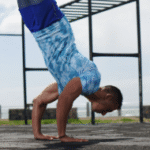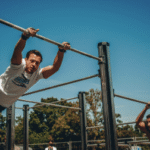How Session Frequency Impacts Your Calisthenics Results
- What is Training Frequency in Calisthenics?
Training frequency refers to the number of times a specific muscle group, movement pattern, or skill is trained per week. For calisthenics, this often translates to:
Muscle Group Frequency: How often you train pushing muscles (chest, shoulders, triceps), pulling muscles (back, biceps), core, or legs.
Skill Frequency: How often you practice a specific skill (e.g., handstands, muscle-ups, front lever progressions).
- Why Session Frequency Matters for Calisthenics Results
The impact of frequency on calisthenics is multi-faceted:
Accelerated Skill Acquisition: Calisthenics is highly skill-based. Just like learning an instrument or a language, consistent, frequent practice of movement patterns leads to faster and more efficient neuromuscular adaptations. Your brain “learns” the movement better through repetition.
Optimized Muscle Protein Synthesis (MPS): MPS is the process by which muscle cells build new proteins, leading to muscle growth (hypertrophy) and repair. Studies suggest that MPS is elevated for about 24-48 hours after a resistance training session. Training a muscle group more frequently within this window can lead to more consistent stimulation for growth.
Enhanced Neuromuscular Adaptation: Higher frequency allows for more frequent “practice” of the brain-muscle connection, improving motor unit recruitment, coordination, and the efficiency with which your nervous system can activate muscles. This is crucial for controlling complex bodyweight movements.
Improved Recovery (with proper management): Counterintuitively, very high frequency can sometimes reduce delayed onset muscle soreness (DOMS) if volume and intensity per session are managed. This allows for quicker recovery between sessions, potentially leading to higher weekly training volume.
Preventing Plateaus: Consistently exposing muscles and the nervous system to stimuli with varying frequencies can help break through plateaus that occur when the body adapts to a monotonous routine.
- Impact of Different Frequencies on Calisthenics Results
The “ideal” frequency is not universal; it depends on individual factors and goals.
Low Frequency (1x/week per muscle group/skill):
Pros: Ample recovery time between sessions, good for general fitness or very high-intensity, high-volume sessions (though challenging to achieve in calisthenics without overtaxing a single muscle group).
Cons: Slower skill acquisition due to less practice, fewer opportunities for MPS spikes, potentially slower strength gains. Less ideal for dedicated calisthenics progression.
Moderate Frequency (2-3x/week per muscle group/skill):
Pros: Often considered a sweet spot for many intermediate calisthenics athletes and for hypertrophy. Provides sufficient stimulus for muscle growth and strength, while allowing adequate recovery. Allows for varied workouts within the week (e.g., Push/Pull/Legs splits or Upper/Lower splits).
Cons: For advanced skill mastery, it might still be insufficient practice.
High Frequency (3-5+x/week per muscle group/skill; often full-body or skill-specific):
Pros: Can significantly accelerate skill acquisition, potentially lead to faster strength and hypertrophy gains (especially if weekly volume is high but distributed), and improve neuromuscular efficiency rapidly. Gymnasts often train skills daily.
Cons: High risk of overtraining, burnout, and overuse injuries (e.g., tendonitis in elbows, wrists, shoulders) if not managed meticulously. Requires precise load management (submaximal effort, avoiding failure in most sets), excellent recovery (sleep, nutrition), and careful periodization. Not suitable for beginners or those with poor recovery habits.
- Factors Influencing Your Ideal Session Frequency
A private calisthenics coach in Houston will consider these factors to tailor your frequency:
Your Goals:
Skill Mastery (e.g., handstands, planche): Often benefits from higher frequency (3-5+ times/week for skill practice, with lower intensity per session) because skill acquisition is highly neurological and benefits from frequent, quality repetitions.
Strength/Hypertrophy: Moderate to high frequency (2-4 times/week per muscle group) can be very effective, ensuring consistent muscle stimulation.
Muscular Endurance: Moderate to high frequency with higher rep ranges.
General Fitness/Maintenance: Lower frequency (2-3 times/week full-body) might be sufficient.
Current Fitness Level:
Beginners: Typically benefit from lower to moderate frequency (2-3 full-body sessions/week) to allow their bodies to adapt, build foundational strength, and learn proper form without excessive soreness or injury risk.
Intermediate/Advanced: Can often tolerate and benefit from higher frequencies, provided volume and intensity are managed carefully.
Recovery Capacity: This is paramount. Factors like:
Sleep Quality and Quantity: Are you getting 7-9 hours of quality sleep?
Nutrition: Is your diet supporting recovery and providing adequate fuel (protein, carbs, fats, micronutrients)?
Stress Levels: High life stress (common in Houston’s demanding work environment) impacts recovery.
Age: Recovery capacity generally decreases with age.
Previous Injuries: Chronic joint issues might necessitate lower frequency for certain movements.
Intensity and Volume per Session: If each session is very high intensity (close to failure) and high volume, then frequency needs to be lower to allow for recovery. If sessions are lower intensity and volume (e.g., “greasing the groove” for skill practice), higher frequency is possible.
Individual Response: Some individuals simply recover faster than others. Listening to your body is key.
Time Availability: A busy Houston schedule might naturally limit frequency, requiring a more efficient program.
- How a Private Calisthenics Coach Manages Session Frequency
A private calisthenics coach in Houston is invaluable for optimizing frequency:
Personalized Programming: They design a program that considers all the above factors, recommending an optimal frequency for your specific body and goals.
Periodization: They integrate frequency changes into your long-term training plan (macrocycles, mesocycles). For example, a “strength block” might have higher intensity and moderate frequency, while a “skill acquisition block” might have higher frequency with lower intensity practice.
Monitoring and Adjustment: They meticulously track your progress, performance, and recovery in each session. If they observe signs of overtraining (e.g., persistent fatigue, decreased performance, joint pain), they can immediately adjust your frequency or recommend a deload week.
Client Education: They teach you how to interpret your body’s signals and understand why certain frequencies are used at different times.
Deload Weeks: They strategically incorporate planned weeks of reduced volume and intensity to allow for full recovery and adaptation, preventing burnout and overuse injuries, especially common when pushing high frequency.
In conclusion, session frequency is a powerful lever in calisthenics training. While higher frequency can accelerate skill acquisition and promote muscle growth, it comes with a higher risk of overtraining if not managed precisely. A private calisthenics coach in Houston is essential for designing a frequency strategy that is perfectly tailored to your individual needs, allowing you to consistently progress towards your calisthenics goals safely and sustainably, no matter how demanding your lifestyle.

How Session Frequency Impacts Your Calisthenics Results
Route
Calisthenics Gym Houston Functional Bodyweight Training
Secondary phone: (346) 483-3195
Email: info@calisthenicsclubhouston.com
URL: https://calisthenicsclubhouston.com/
Monday 6:00 AM - 7:00 PM Tuesday 6:00 AM - 7:00 PM Wednesday 6:00 AM - 7:00 PM Thursday 6:00 AM - 7:00 PM Friday 12:00 PM - 6:30 PM Saturday 9:45 AM - 12:00 PM Sunday 3:00 PM - 5:00 PM





